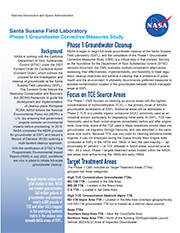
The California Department of Toxic Substances Control (DTSC) has announced the release of the NASA Phase 1 Groundwater Corrective Measures Study (CMS) and the DTSC Statement of Basis for the groundwater cleanup at the Santa Susana Field Laboratory (SSFL) — key documents under the Resource Conservation and Recovery Act (RCRA) cleanup process.

As part of the Agency's continuing effort to address cleanup of groundwater under the 2007 Order for Corrective Action, NASA has kicked off its pilot study to test the effectiveness of bedrock vapor extraction (BVE) to clean up contamination in the underlying bedrock matrix beneath the Santa Susana Field Laboratory (SSFL). A fact sheet has been developed to provide a summary of how BVE works and provide more information about the BVE pilot study system that is in place at SSFL.

NASA is committed to using “green” treatment technologies at SSFL wherever possible to minimize impacts to the site’s unique ecosystem. NASA has developed a fact sheet summarizing NASA’s pilot study that is testing the effectiveness of one such treatment approach: enhanced in situ bioremediation (EISB).

PFAS are classified as unregulated or “emerging” contaminants, which means there are currently no federal regulatory standards or routine water quality testing requirements. NASA is taking a forward-leaning approach to PFAS and is implementing an agency-wide initiative to identify past uses and possible source locations of PFAS at NASA facilities, including SSFL. NASA produced a fact sheet to summarize NASA’s PFAS investigation at SSFL.

NASA is making progress toward the cleanup of groundwater in NASA areas at SSFL in line with the 2007 Consent Order. For an update on NASA’s efforts, including next steps, please view our infographic on Cleaning up Groundwater at the Santa Susana Field Lab.

NASA prepared a fact sheet about the soil cleanup process, including information about a Suburban Residential Cleanup that NASA described in its October 2020 Record of Decision for Soil Cleanup at SSFL.

NASA has prepared a Fact Sheet for the Final SEIS summarizing the purpose of the Final SEIS, the Alternatives evaluated, and the Preferred Alternative.

NASA has prepared a Draft Supplemental Environmental Impact Statement for Soil Cleanup Activities at Santa Susana Field Laboratory (SSFL) summarizing the purpose and need for a SEIS, the Alternatives evaluated, and a brief overview of the findings.

This fact sheet provides a brief overview of the historical operations carried out on NASA-administered land at SSFL. It describes demolition, groundwater and soil cleanup actions underway as part of NASA's commitment to clean up chemicals that remain from past operations at SSFL.

This fact sheet provides a description of the proposals and alternatives being considered for the Environmental Impact Statement being prepared for SSFL.

This fact sheet provides a look back at NASA's rocket engine testing at SSFL, primarily for the Apollo Program and the Space Shuttle Main Engine, beginning in the 1950s through the 1990s.

A site-wide Cultural Resources Inventory of federally-owned Areas I and II was completed in April 2008. The goals of this survey were twofold: to determine whether there were any previously unrecorded cultural resources on the lands administered by NASA, and to better understand the nature and extent of the previously recorded Burro Flats Painted Cave site. This effort assists NASA in complying with Section 110 of the National Historic Preservation Act (NHPA), which directs Federal agencies to identify historic properties, including archaeological resources. Having this comprehensive inventory enables NASA to better manage these resources.

Federal statutes guide federal agency stewardship of historic resources under their control and provides direction for establishing programs to manage their historic resources.
Updated 2012-02-17: Coca test stand numbers corrected on page 3.
You also may read the entire Historic Resources Survey and Assessment.

Currently, NASA is implementing a short-term action used to prevent or mitigate risks to human health or the environment before a final remedy has been selected. NASA’s Interim Source Removal Action (ISRA) is designed to remove potential sources of contaminants and improve the quality of surface water discharge.

NASA administers 451.2 acres of federal property in two areas of the Santa Susana Field Laboratory (SSFL) and has operated here since 1973, when we first acquired land from the U.S. Air Force (USAF). Prior to 1973, NASA and the U.S. Department of Defense (DoD) conducted testing at SSFL in cooperation with the USAF. NASA recognizes the importance of communicating directly with the community regarding our properties, current and former operations at SSFL and the ongoing environmental cleanup taking place. NASA is committed to a cleanup of the areas we administer to a level protective of public health and the environment. This literature is part of our efforts to keep you informed.

Trichloroethylene (TCE) is a non-flammable, colorless liquid that belongs to a group of chemicals known as Volatile Organic Compounds (VOCs). It is used mainly as a solvent for removing grease from metal parts, and in adhesives, paint removers and spot removers.